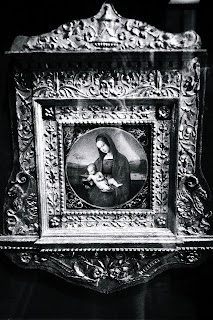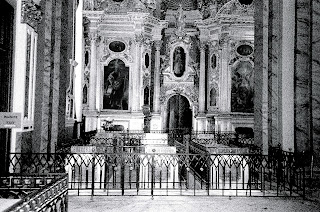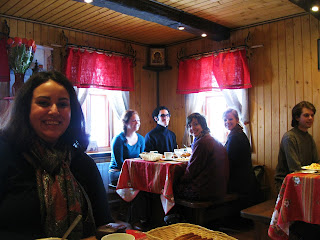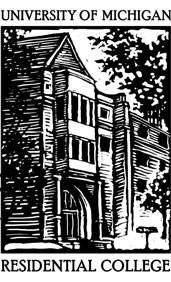In the United States, we heard a lot about individualism. We pass the word around frequently, but my interactions with Vytegrans have been a truly dramatic example of people with skills and passions, people ready to offer and flaunt their talents. On the first day, we were treated to a traditional Russian dance – and then a tango; to a rendition of ДДТ's "Осень" – and then two girls' original compositions. The variety of interests and dedication these students have to their studies and hobbies affirms that while the road from Saint Petersburg to Vytegra may not paved, it leads to somewhere unique and enthralling.
Wednesday, February 29, 2012
There is a reason it's called the House of Culture
In the United States, we heard a lot about individualism. We pass the word around frequently, but my interactions with Vytegrans have been a truly dramatic example of people with skills and passions, people ready to offer and flaunt their talents. On the first day, we were treated to a traditional Russian dance – and then a tango; to a rendition of ДДТ's "Осень" – and then two girls' original compositions. The variety of interests and dedication these students have to their studies and hobbies affirms that while the road from Saint Petersburg to Vytegra may not paved, it leads to somewhere unique and enthralling.
My guide was very insightful and I think we both learned a lot from each other. Some of the things I learned from her included:
1) Wedding rings in Russia are worn on the right hand instead of the left and share the same myth about the blood vessel running from that finger all the way to the heart. (I had learned this because she had asked me what my silver ring with elephants on my right hand meant)
2) Russians find it strange that Americans are always drinking water or have bottled water on them.
3) Dean Martin's "Make Me Sway" is an incredibly popular song in Russia, as well as "O Susanna"
When we went to visit with the Russian youth group, we were put to shame yet again as the kids completely destroyed us in dance battles, but as many members of our group put it, they did have the home field advantage.
Today, however, I went to work at the museum and afterwards, joined back up with the group to visit the Klyuev museum and the church in Vytegra, shown in the pictures above.
 Vytegra is like many small towns in the United States, if incredibly more isolated. The only way to travel to this town is by vehicle and a 6-10 hour drive. The local businesses are not chains stores, everyone knows everyone else, and the children are incredibly interested in the world beyond Vytegra's borders.
Vytegra is like many small towns in the United States, if incredibly more isolated. The only way to travel to this town is by vehicle and a 6-10 hour drive. The local businesses are not chains stores, everyone knows everyone else, and the children are incredibly interested in the world beyond Vytegra's borders.The residential and business have no direct boundaries, and in many cases the owner live behind the store front in a attached apartment.
Tuesday, February 28, 2012
But then what can you expect from St. Petersburg? It was a city built to imitate and impress the west, to prove that Russia, too, is a high culture. The buildings remind me of those that I saw in Vienna. Traditional Russian architecture, such as the multicolored copolas any westerner would expect, is hard to come by. The western influence is most evident in the Hermitage, Russia's most famous art museum, an astounding palace built by some of Russia's greatest rulers, with rooms of breathtaking architecture and design, all filled with (wait for it...) western art. Of course, there were works by Rembrandt, Raphael, and even Leonardo DaVinci (not to mention a few of the impressionists tucked away in the old servant's quarters), yet not once did I see a work by Repin or Perov.
The western influence is less visible in Vytegra, and for that I am rather thankful. I feel that I am in the true Russia that I have read so much about in Chekhov and Gogol. The snow glistens across the roofs of wooden houses with piles of wood outside, the city stands quiet, lacking the bustle of St. Petersburg (in the most wonderful way). But still, the west works its way in in the most surprising and interesting ways. Today at one of the schools, we had an extensive conversation about Star Trek and Doctor Who with one of the students. Earlier that day the student's and performed for our enjoyment a lovely adaptation of Cinderella (they acted and spoke wonderfully!), with a soundtrack of American music, none of which i recognized, though I think most of it was from the eighties. It surprises me to see what music makes its way across the Atlantic. I once heard Rick Astley playing in a bathroom in Prague. It seemed so out of place at the time, but I laughed it off.
On a side note, the bus broke down in the night on the way to Vytegra. It was up and running again quite quickly, but that time time we had sitting in the middle of the snowy road, talking, staring into the sky, and debating weather it was worth it to go through knee deep snow drifts to find a suitable tree, was probably the best part of that bus ride.
The Voyage to Vytegra
A brief stop at a cafe in the countryside was an interesting experience. The cafe was nice, offered a decent variety of foodstuffs, and had a modern look to it. But then there was...the restroom. I walked in and it seemed like a normal and relatively clean restroom, with stalls and sinks, and I saw attractive and stylish women entering them. But once I opened the stall, the weirdness began. In front of me was a hole in the ground. No toilet paper, no seat...just a hole. This may be a crude topic for discussion, but striking nonetheless. I immediately felt like all of the Western qualities of St. Petersburg were flushed down the toilet (or a lack thereof).
Soon we reached the village near the Alexander-Svirsky monastery. Before touring it, we ate a traditional Russian meal in a small restaurant. Upon entering the room, I immediately noticed the icon in the corner, the sweltering heat inside, and the decor that was vaguely reminiscent of an "izba" (peasant hut) out of a folktale; a quite different atmosphere than that of the European style of St. Petersburg.
But apparently Russia is not the only possessor of "backwardness". Our group was instructed to enter a room containing a holy relic, where we could not take photographs, and we could either kiss the icon, cross ourselves, or merely observe. But we were given one instruction: "Do not turn your back to the alter". As we stood nervously near this holy relict, we stood facing the intricate golden altar near the icon. We then preceded to walk backwardly out of the room, awkwardly shuffling, terrified to turn our heads. The other visitors and pilgrims gave us strange looks. As it turned out, we had not quite understood the instructions. We were supposed to not stand facing our backs to the altar, but we were allowed to walk away from it normally!
The rest of the bus ride took us through vast, seemingly never-ending forest. The snow-strewn conifers stood silently and stately. Occasionally we would see location signs, and the further we drove, the less Russian the names were. I wonder if they were derived from the Finno-Ugric people that originally inhabited the area.
It soon became dark. We were told that we were not far from our destination. Staring out my window, I caught glimpses of tiny, wooden houses with warm, glowing light streaming through their windows. What were behind those windows? Was there traditional Russianness, warmth and comfort, old babushkas and their families tending to the stoves, heating their samovars? Or were there drunken gatherings, rowdiness, secret lust and hidden demons... Here we are. We have entered the heartland.
 In the lovely, but very Western-European city of St. Petersburg, we were given a tour of the city and the stunning Hermitage by our knowledgeable guide. It was clear to see that we could explore the Winter Palace and the Hermitage all day and night and still not see all there was to see and learn all there is to know about both the art movements and painters and the history of the Russian Imperial power and expansion towards a broad, world power that is culturally renown today.
In the lovely, but very Western-European city of St. Petersburg, we were given a tour of the city and the stunning Hermitage by our knowledgeable guide. It was clear to see that we could explore the Winter Palace and the Hermitage all day and night and still not see all there was to see and learn all there is to know about both the art movements and painters and the history of the Russian Imperial power and expansion towards a broad, world power that is culturally renown today.
This visitation of the Winter Palace and the Hermitage were especially exciting and meaningful for me. I have read a biography on Catherine the Great as well as another about Peter the Great; so, connecting the history of Catherine’s contributions and strikingly large personality to the location that brought culture to both St. Petersburg and Russia from Europe was seeing something I had daydreamed about - the place where Catherine had strolled with her gentlemen friends and improved her meager education and background as well as her country’s was euphoric. Though I knew that much of the art in the Hermitage is not of Russian movements or artists, I was surprised that we saw none at all by a native-Russian. Emphasis was very much upon the greatest, most famous – but not Russian – artists of the time; and the sheer volume of the collections of these was astonishing.
Monday, February 27, 2012
The next day, we got to experience St. Petersburg, beginning the morning at The Hermitage. I found the museum to be a beautiful representation of the "modernized" city. Having visiting the Louvre before, I could not help but compare the two. The Hermitage did not lack the impressive repertoire that the Louvre has, even with two million less pieces. We visited the work of almost every major painter that I have heard of (in my limited knowledge of art) along with many others, though I did notice the lack of Russian art. What I found more striking than the Louvre was The Hermitage’s lodgings. The Winter Palace took my breath away more often than its paintings and sculptures. I found myself taking many pictures of doors, floors, chandeliers, and ceilings rather than the art hanging on the walls. While the architectural ideas were taken from other countries, the magnificence from them all stood collaged together in these buildings housed in St. Petersburg.
After an amazing lunch, we headed off to see more of the city and shop. The Church on the Spilled Blood and the Peter and Paul Fortress where more of the architectural triumphs that we were able to experience up close. There were also many more sights that flew by during our bus tour of the city. Exhausted, we stopped back at our dorm for food and then went off again to experience the city at night. The metro was an experience in itself, so exciting that I made sure to ride it twice. I soon grew tired and had to end my excursion in St. Petersburg and prepare for the day-long bus ride to Vytegra.
St. Petersburg Sights
Here we have the Winter Palace, which contained Catherine the Great's art collection.

The Historic District of St. Petersburg is made in a similar vein to the Winter Palace, and creates an artificial feel of what St. Petersburg is like. Outside of the military museums and various palaces, industry lies. Construction sights are common sights outside the Historic District, though few are actually being worked in. Some apartment buildings stand silent as the city’s population slowly decreases.
We also visited the Peter and Paul Fortress and saw the tombs of the Czars. Some of the Fortress was under recontruction. All the tombs were very simplistic with few adornments, in the modest way of Russian Orthodoxy, while the icons were very lavish.










































